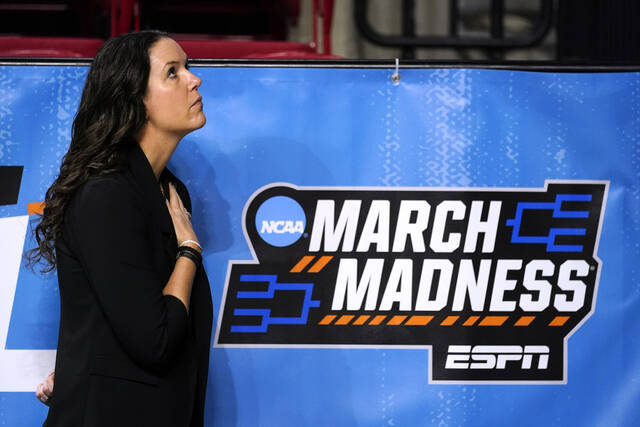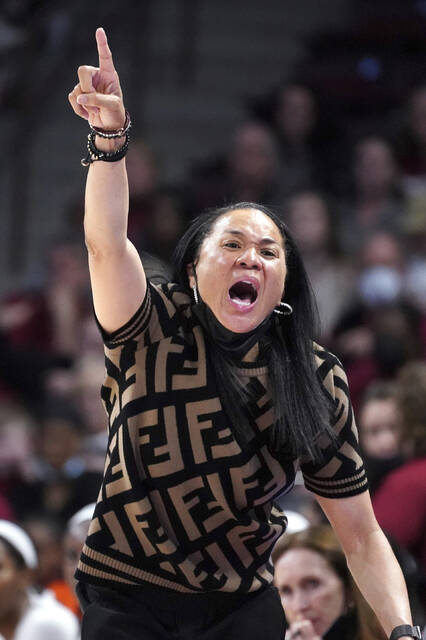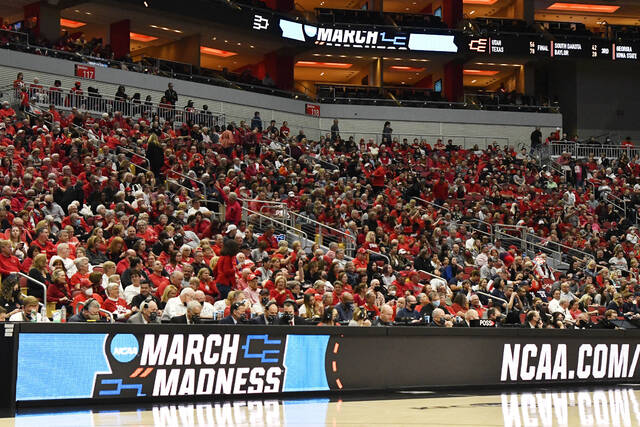


The phrase “March Madness” is everywhere this women’s NCAA Tournament.
On scoreboards in place of team names during practices. Scrolling on video ribbon boards. On banners inside the arenas. On the courts themselves with a bit of TV magic through the first two rounds. On hats given to both women and men with swag boxes that are equal for both men’s and women’s players this spring after an uproar at the tourney a year ago.
It’s a start. It’s also not enough for the coaches and players — and presumably the NCAA. Growing women’s basketball is more than logos, gifts and an equal number of teams, now 68 for both for the first time. South Carolina coach Dawn Staley has an idea the NCAA can implement immediately to really help women close the gap with the men.
“The units,” Staley explained, meaning money. “Like men’s basketball, they get units, and those units equal dollar signs. I would like for us to divvy it up like the 68 teams get (their money) divvied up once the tournament ends.”
Men’s conferences get a unit valued this year at $338,210.96 for each NCAA Tournament game one of their teams plays. The money goes to each team’s conference paid out over six years with a true value around $2.03 million. That means the Big Ten will get more than $18 million thanks to having nine teams in this tournament field.
Stanford, the women’s national champion in 2021, got no money for making the tournament field. None of the 68 teams this season will either.
Sending money to the women’s programs is something that has to go through a handful of committees for the NCAA to make that happen.
It’s easier to pay the men thanks to the NCAA’s deal with CBS and Turner’s contract. The original contract averaged $770 million per year with an extension in 2016 jumping that per-year average to $1.1 billion in 2025.
“Now, it’s not going be what the men’s side is,” Louisville coach Jeff Walz said of revenue sharing, should it happen. “Just something would be impressive.”
The women’s tournament currently is bundled with other women’s championships for TV rights. The current contract with ESPN is up in 2024. ESPN is giving each game in this tournament its own window on one of its channels with four games on ABC for a second straight year.
Belmont coach Bart Brooks noted his 12th-seeded Bruins’ double-overtime upset of Oregon was on national television available to everyone rather than being limited to a regional market as it would’ve been in previous tournaments.
“That was huge, that little girls who have never heard of Belmont maybe say, ‘Hey, that’s a pretty cool little basketball team they have, maybe I’ll look into that school,’” Brooks said. “I think that’s just good for the game, to have that exposure.”
All the changes at this tournament came after 2021 social media posts, most notably that of Oregon forward Sedona Prince, exposed some of the glaring inequities between the men and women. A law firm hired to review gender equity issues at NCAA championship events outlined the differences in a blistering report last summer.
In a letter sent just before this year’s tournament, three congresswomen called out NCAA President Mark Emmert for not shaking up the basketball management structure, including adding a business officer to deal with TV networks and marketing for all championships.
Utah coach Lynn Roberts said she thinks the NCAA is working hard to fix some of the optics with “a long ways to go” systematically. Roberts said the real money comes from media deals and advertising.
“If we are talking about true equity, the resources need to be the same,” Roberts said.
Oregon coach Kelly Graves joked that he threatened to make Prince run after sitting through a 45-minute Zoom call after the bracket announcement detailing the changes to improve equity for this year’s women’s tournament. Turning serious, Graves said the changes were long overdue and he was proud his Ducks feel they can speak up.
“That being said, we still can’t rest,” Graves said. “We’ve got a ways to go.”
For years, Graves has been among those wanting to move from campus sites hosting the first and second round games to neutral sites, which is what the men’s tournament does. The NCAA will use a neutral site for the women’s First Four next year; this year’s inaugural version was played at four different locations that all then hosted early-round games at host schools in the field.
“Whether that’s 16 teams at one site in the first and second rounds, whatever the format, I just think our game is growing,” Graves said. “Our game is really, really strong right now.”
The women’s tournament set an an attendance record of 216,890 through the first two rounds. The home-court advantages didn’t help that much: Eight double-digit seeds won, tying 2018 for the most ever through two rounds. Four top-four seeds lost at home by double digits for the first time.
“I don’t know if we’re totally ready for that entirely yet, but I think getting more games on TV and having these upsets are showing the quality of play,” North Carolina coach Courtney Banghart said after he r Tar Heels routed Arizona in Tucson on Monday night.
The NCAA selection committee has had not yet discussed moving first- and second-round games to neutral sites. That topic will be talked about after the April 3 championship game in Minneapolis.
“We have to continue to grow attendance and there needs to be more research done,” Women’s Basketball Coaches Associatioin president Cori Close said.
For the players and coaches, the constant March Madness logos made home arenas actually feel like the NCAA Tournament.
“I don’t think we want the exact same thing,” said Arkansas guard Makayla Daniels. “I think we want it to be catered to us. That’s how it should be. It should be different but fit the needs of male athletes and female athletes.”
Truly measuring how the NCAA fixes gender inequities will be something to watch over the next few years.
“Let’s just continue to lift our tournament up, and hopefully we’ll find ourselves in a revenue-producing tournament,” Staley said.
___
AP Basketball Writers Doug Feinberg and Aaron Beard, Associated Press writer Jeffery Collins and AP Sports Writers Pete Iacobelli, Jim Vertuno, Noah Trister, Stephen Hawkins, Janie McCauley, Cliff Brunt, Pat Eaton-Robb and Gary Graves contributed to this report.
___
More AP coverage of March Madness: https://apnews.com/hub/march-madness and https://apnews.com/hub/womens-college-basketball and https://twitter.com/AP_Top25




